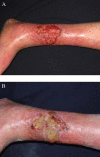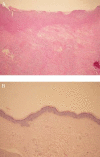Therapy-resistant leg ulcer in a patient with Rothmund-Thomson syndrome
- PMID: 20860557
- PMCID: PMC7951505
- DOI: 10.1111/j.1742-481X.2010.00734.x
Therapy-resistant leg ulcer in a patient with Rothmund-Thomson syndrome
Abstract
Rothmund-Thomson syndrome (RTS) is a rare genodermatosis with characteristic skin changes such as atrophy, abnormal pigmentation and telengiectasias, skeletal abnormalities, short stature, juvenile cataract and predisposition to skin and bone malignancies. Data from the literature suggest that cutaneous findings of the syndrome include genetically programmed ageing changes and DNA repair abnormalities related to photosensitivity. Our patient is a 23-year-old male who presented with an unhealing ulcer for one and a half year on his left leg. Although he had received many various treatments, there had been no significant improvement during this period. We believe that this failure of healing might be to DNA repair abnormalities of fibroblasts. To our knowledge, this is the first case reported with coexistence of an unhealing ulcer without any findings of malignancy and RTS.
© 2010 The Authors. Journal Compilation © 2010 Blackwell Publishing Ltd and Medicalhelplines.com Inc.
Figures



Similar articles
-
Leg ulcer in a patient with Rothmund-Thomson syndrome.Springerplus. 2015 Oct 5;4:572. doi: 10.1186/s40064-015-1374-z. eCollection 2015. Springerplus. 2015. PMID: 26543707 Free PMC article.
-
Rothmund-Thomson syndrome: two case reports show heterogeneous cutaneous abnormalities, an association with genetically programmed ageing changes, and increased chromosomal radiosensitivity.J Med Genet. 1996 Nov;33(11):928-34. doi: 10.1136/jmg.33.11.928. J Med Genet. 1996. PMID: 8950673 Free PMC article.
-
[The Rothmund-Thomson-syndrome. A case report].Hautarzt. 1975 Aug;26(8):425-9. Hautarzt. 1975. PMID: 170234 German.
-
An unusual patient with Rothmund-Thomson syndrome, porokeratosis and bilateral iris dysgenesis.Clin Exp Dermatol. 2006 May;31(3):401-3. doi: 10.1111/j.1365-2230.2006.02080.x. Clin Exp Dermatol. 2006. PMID: 16681588 Review.
-
Short root anomaly associated with Rothmund-Thomson syndrome.Oral Surg Oral Med Oral Pathol Oral Radiol Endod. 2007 Jan;103(1):e19-22. doi: 10.1016/j.tripleo.2006.07.021. Epub 2006 Oct 24. Oral Surg Oral Med Oral Pathol Oral Radiol Endod. 2007. PMID: 17178481 Review.
Cited by
-
Clinical utility gene card for: poikiloderma with neutropenia.Eur J Hum Genet. 2013 Oct;21(10). doi: 10.1038/ejhg.2012.298. Epub 2013 Jan 16. Eur J Hum Genet. 2013. PMID: 23321617 Free PMC article. No abstract available.
-
Novel C16orf57 mutations in patients with Poikiloderma with Neutropenia: bioinformatic analysis of the protein and predicted effects of all reported mutations.Orphanet J Rare Dis. 2012 Jan 23;7:7. doi: 10.1186/1750-1172-7-7. Orphanet J Rare Dis. 2012. PMID: 22269211 Free PMC article.
-
Leg ulcer in a patient with Rothmund-Thomson syndrome.Springerplus. 2015 Oct 5;4:572. doi: 10.1186/s40064-015-1374-z. eCollection 2015. Springerplus. 2015. PMID: 26543707 Free PMC article.
-
Clericuzio-type poikiloderma with neutropenia and leg ulceration.JAAD Case Rep. 2023 Sep 27;48:26-29. doi: 10.1016/j.jdcr.2023.08.045. eCollection 2024 Jun. JAAD Case Rep. 2023. PMID: 38741660 Free PMC article. No abstract available.
References
-
- Mak RKH, Griffiths WAD. Mellerio. An unusual patient with Rothmond‐Thomson syndrome, porokeratosis and bilateral iris dysgenesis. Clin Exp Dermatol 2006;31:401–3. - PubMed
-
- Wang LL, Levy ML, Lewis RA, Chintagumpala MM, Lev D, Rogers M, Plon SE. Clinical manifestations in a cohort of 41 Rothmond‐Thomson syndrome patients. Am J Med Genet 2001;102:11–17. - PubMed
-
- Stinco G, Governatori G, Mattighello P, Patrone P. Multiple cutaneous neoplasms in a patient with Rothmund‐Thomson syndrome: case report and published work review. J Dermatol 2008;35:154–61. - PubMed
-
- Anbari KK, Ierardi‐Curto LA, Silber JS, Asada N, Spinner N, Zackai EH, Belasco J, Morrissette DJ, Dormans JP. Two primary osteosarcomas in a patient with Rothmund‐Thomson syndrome. Clin Orthop Relat Res 2000;378:213–23. - PubMed
Publication types
MeSH terms
Substances
LinkOut - more resources
Full Text Sources
Medical

